Rheinmetall Denel Munition has finalized a ten-year agreement with Northrop Grumman to develop precision and long-range ammunition technology for future artillery operations.
The agreement signed this February, will see the joint venture focus on developing and offering enhanced ammunition technology to the international market, including the United States, to support future artillery operations.
As part of the partnership, both companies will focus on developing an enhanced range 155 mm artillery round fitted with an integrated M1156 precision guidance kit (PGK), as well as on developing a new 155 mm projectile with an improved integrated propulsion system.
A press release published this month explained “In combination with Rheinmetall’s V-LAP [Velocity Enhanced Long-Range Artillery Projectile], which currently achieves the longest maximum range of any conventional artillery projectile, the M1156 PGK results in a swiftly available solution, proven in numerous combat operations, for long-range precision-guided munitions.”
In service with a number of armed forces, the M1156 PGK is an inexpensive, immediately available means of enhancing the accuracy of existing types of artillery ammunition.
The longest range ever attained by a conventional artillery projectile currently stands at 76 kilometres, achieved in 2019 at the Alkantpan test range with a non-NATO Joint Ballistics Memorandum of Understanding (JBMOU)-conforming 52-calibre gun and RDM 155mm projectile.
The armed forces of more than twelve nations now use enhanced range Rheinmetall artillery ammunition from South Africa.
The integration of tried-and-tested technologies results in a quick increase in capabilities and combat power. Furthermore, other NATO nations and non-JBMOU users can adopt this solution based on Rheinmetall’s existing artillery portfolio.
Rheinmetall and Northrop Grumman have conducted testing of the V-LAP projectile variants and PGK in South Africa early in 2021, and are intending to demonstrate it later at the US Army proving ground in Yuma, Arizona.
